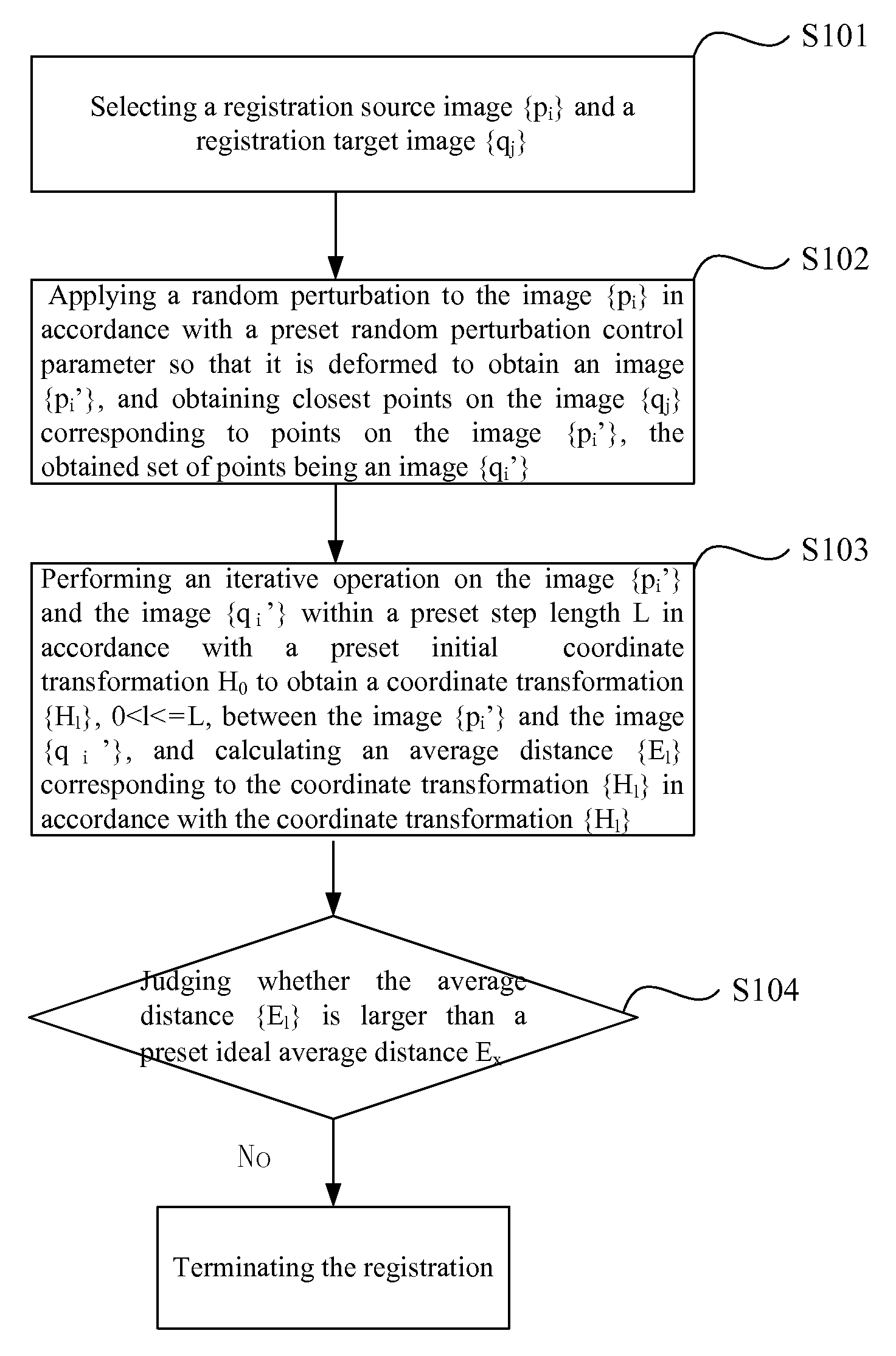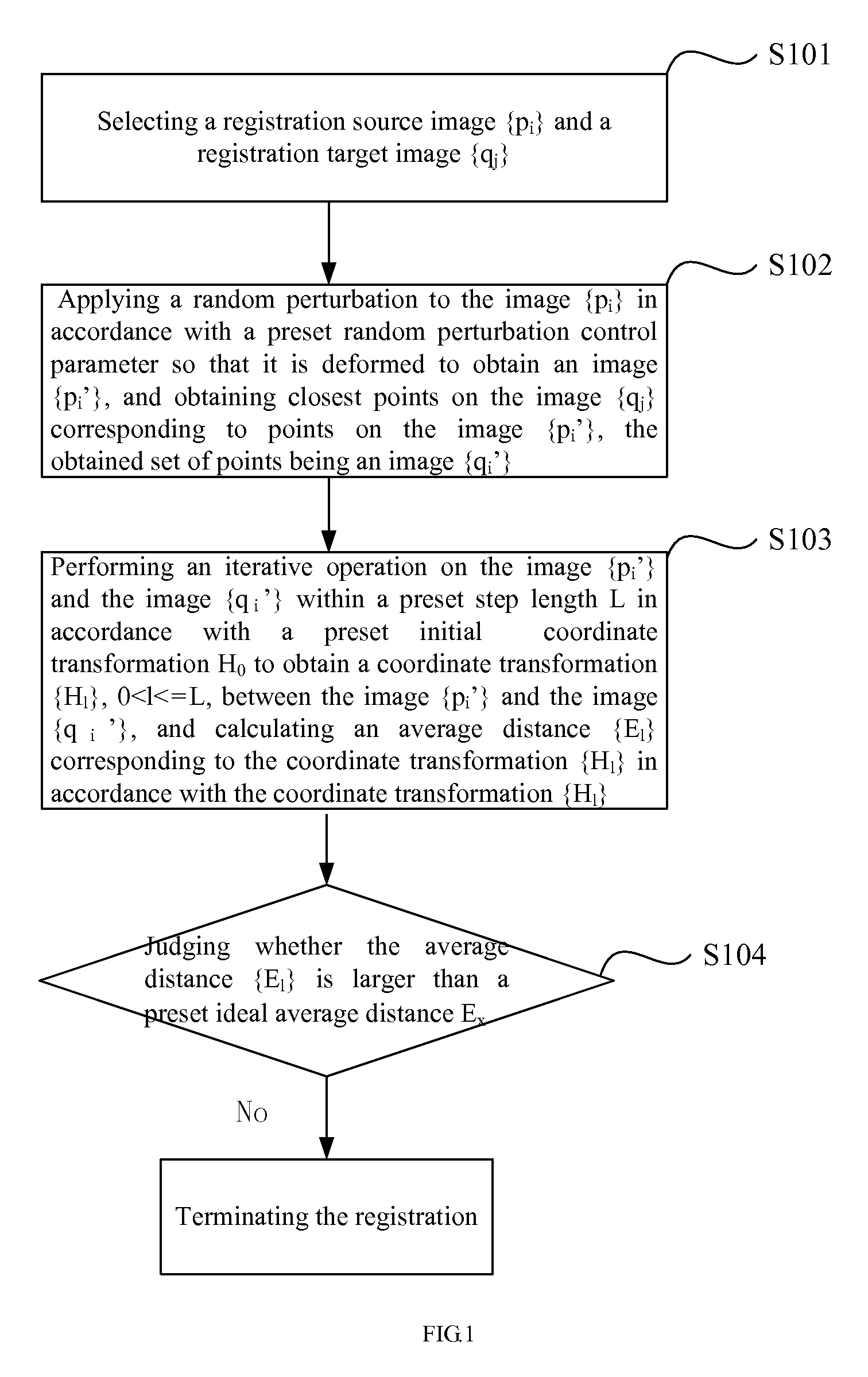Image registration method
a registration method and image technology, applied in the field of image processing, can solve the problems of unable to meet actual requirements, merely using one kind of image data can hardly meet actual requirements, and the accuracy and success rate of image registration are comparatively low, so as to improve the registration accuracy and registration success rate
- Summary
- Abstract
- Description
- Claims
- Application Information
AI Technical Summary
Benefits of technology
Problems solved by technology
Method used
Image
Examples
embodiment 1
[0044]FIG. 1 is a schematic diagram of a flow of an image registration method provided in Embodiment 1 of the present application.
[0045]As shown in FIG. 1, the method comprises:[0046]Step S101: selecting a registration source image {pi} and a registration target image {qj}, the registration source image being {pi|i=1, . . . , M}, the registration target image being {qj|j=1, . . . , N}, Mi} and the registration target image {qj} being located in different coordinate systems, and {pi}=H*{qi}
[0047]H=[R0T1],[0048] wherein 0[0049]Step S102: applying a random perturbation to the image {pi} to deform it in accordance with a preset random perturbation control parameter σ so as to obtain an image {pi′}, and obtaining closest points on the image {qi} corresponding to points on the image {pi′}, the obtained set of points being an image {qi′}.
[0050]Firstly applying the random perturbation to the registration source image {pi}, specifically:[0051]adding a random perturbation ni that meets normal...
embodiment 2
[0064]FIG. 2 is a schematic diagram of a flow of an image registration method provided in Embodiment 2 of the present application.
[0065]As shown in FIG. 2, step S201˜step S204 in the embodiment of the present application are the same as step S101˜step S104 in Embodiment 1, and no further descriptions are given herein. In step S204, if the average distance {E1} is larger than the preset ideal average distance Ex, this method can further comprise steps of:[0066]step S205: judging in turn whether the average distance {E1} is larger than an initial average distance E0, wherein the initial average distance E0 is corresponding to the initial coordinate transformation H0;[0067]step S206: if not, terminating the judgment between the average distance {Ei} and the initial average distance E0, replacing the initial coordinate transformation H0 with a coordinate transformation Hg corresponding to a current average distance Eg, decaying the random perturbation control parameter σ in accordance w...
embodiment 3
[0070]FIG. 3 is a schematic diagram of a flow of an image registration method provided in Embodiment 3 of the present application.
[0071]As shown in FIG. 3, step S301˜step S304 in the embodiment of the present application are the same as step S101˜step S104 in Embodiment 1, and no further descriptions are given herein. In step S304, after judging the magnitudes of the average distance {E1} and the preset ideal average distance Ex, this method can further comprise steps of:[0072]step S305: selecting the minimum average distance Emin in the average distance {E1};[0073]step S306: judging whether the minimum average distance Emin is larger than the initial average distance E0, wherein the initial average distance E0 is corresponding to the initial coordinate transformation H0;[0074]step S307: if not, replacing the initial coordinate transformation H0 with a coordinate transformation Hmin corresponding to the minimum average distance Emin, decaying the random perturbation control paramete...
PUM
 Login to View More
Login to View More Abstract
Description
Claims
Application Information
 Login to View More
Login to View More - R&D
- Intellectual Property
- Life Sciences
- Materials
- Tech Scout
- Unparalleled Data Quality
- Higher Quality Content
- 60% Fewer Hallucinations
Browse by: Latest US Patents, China's latest patents, Technical Efficacy Thesaurus, Application Domain, Technology Topic, Popular Technical Reports.
© 2025 PatSnap. All rights reserved.Legal|Privacy policy|Modern Slavery Act Transparency Statement|Sitemap|About US| Contact US: help@patsnap.com



